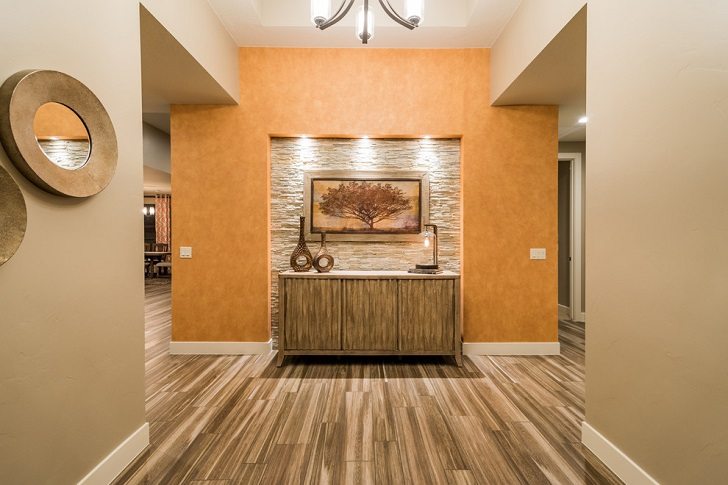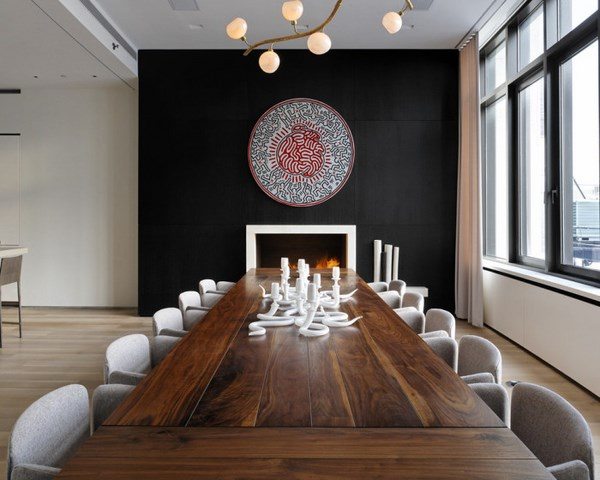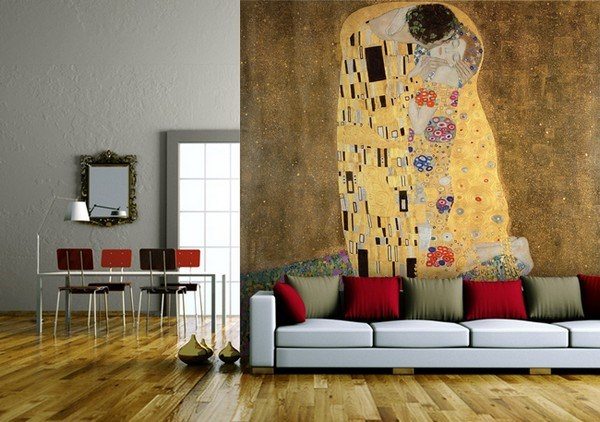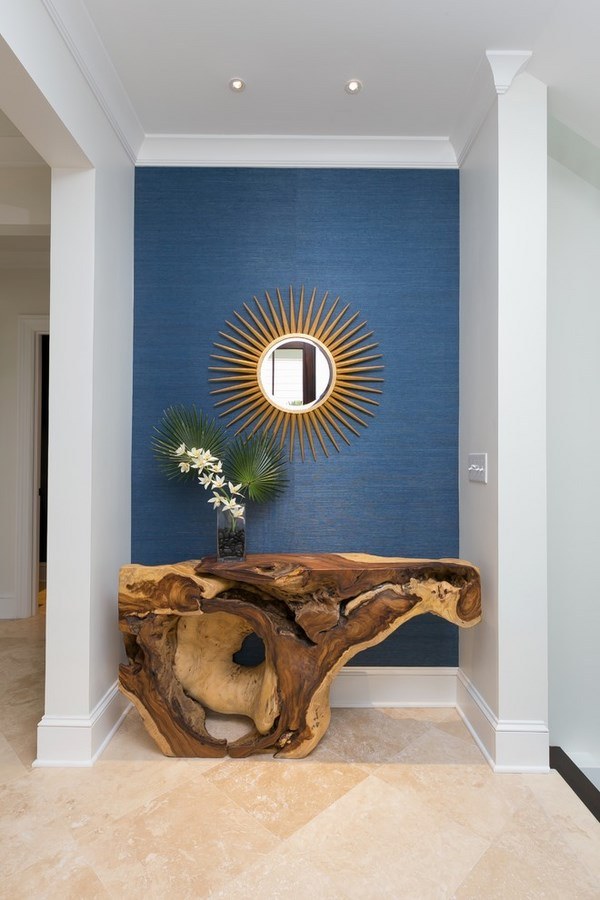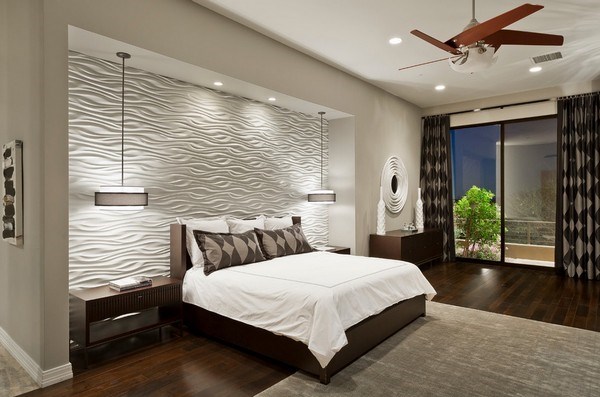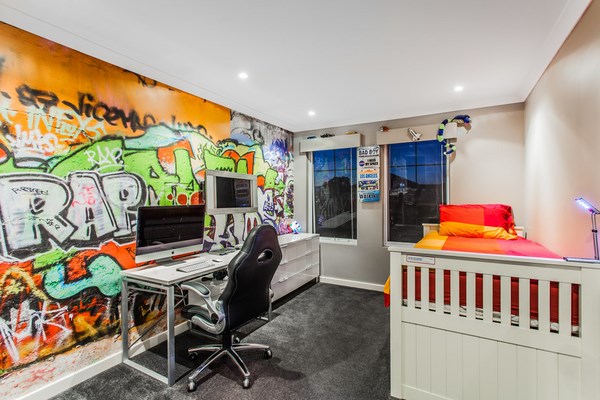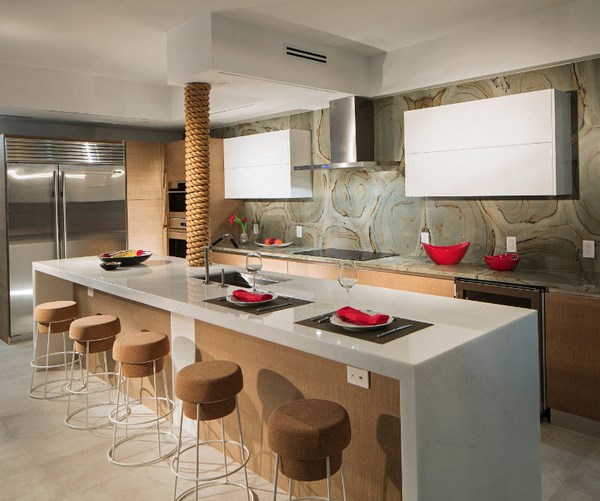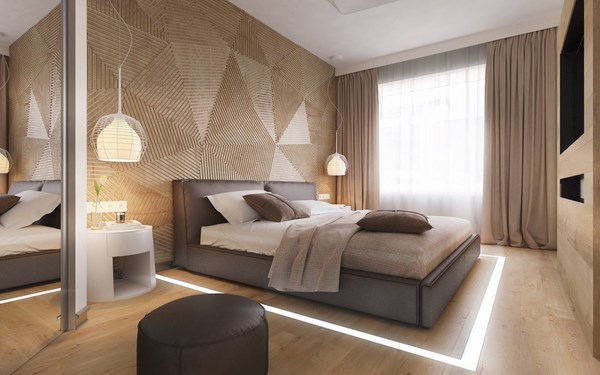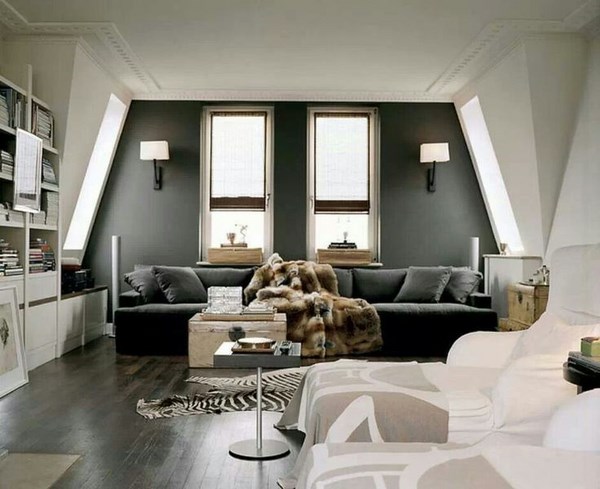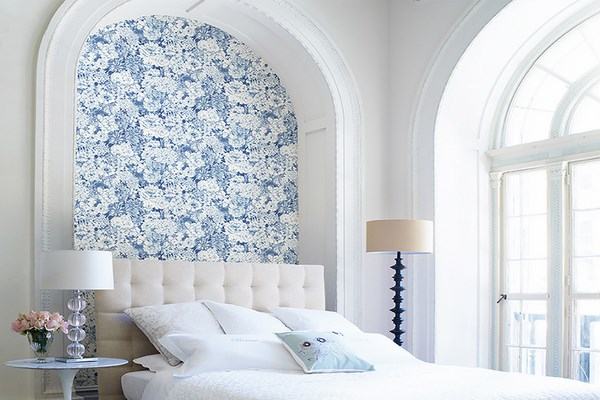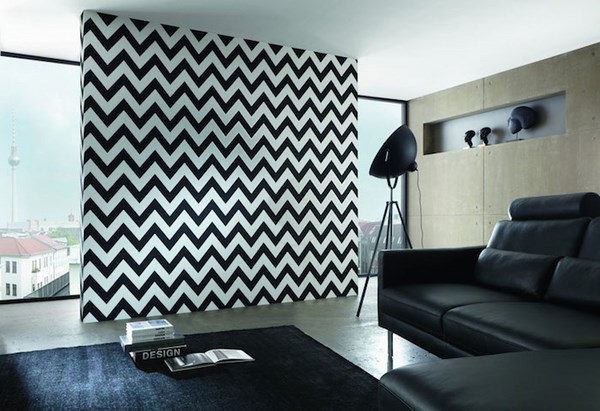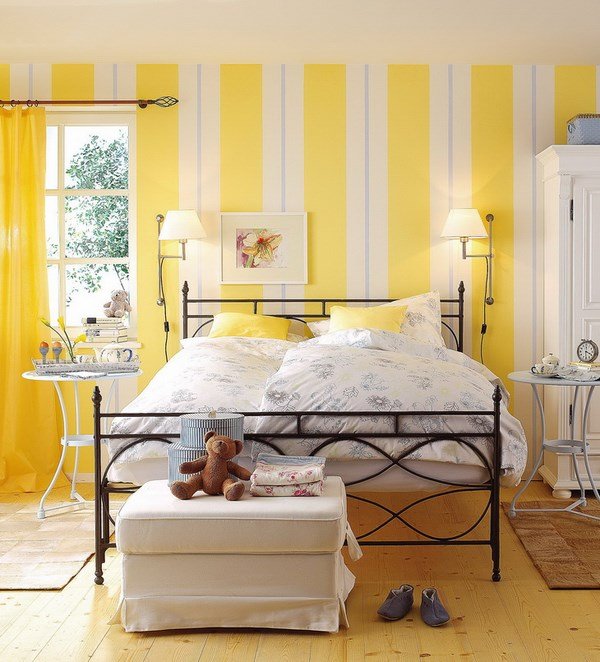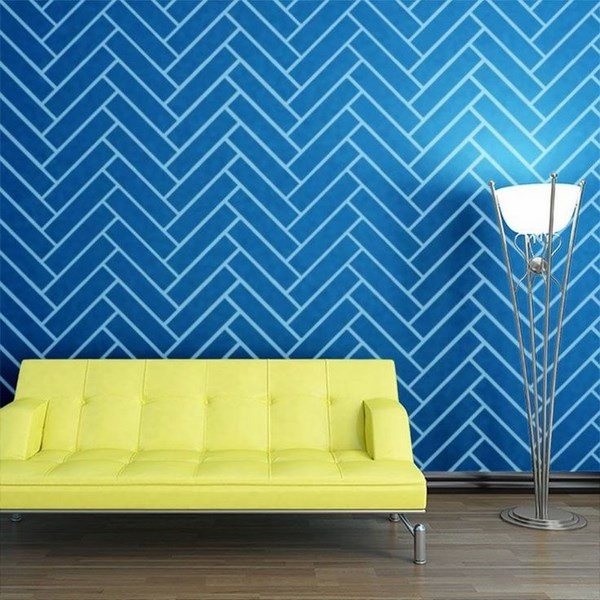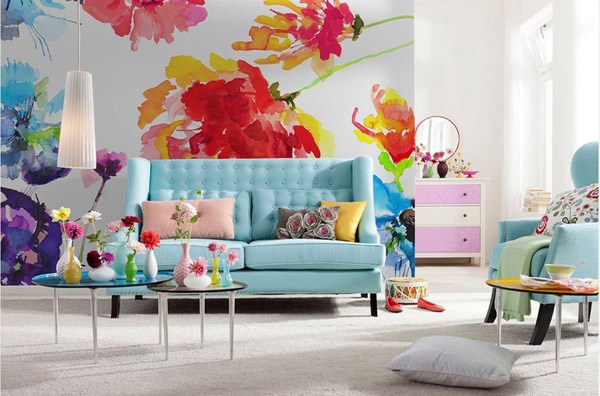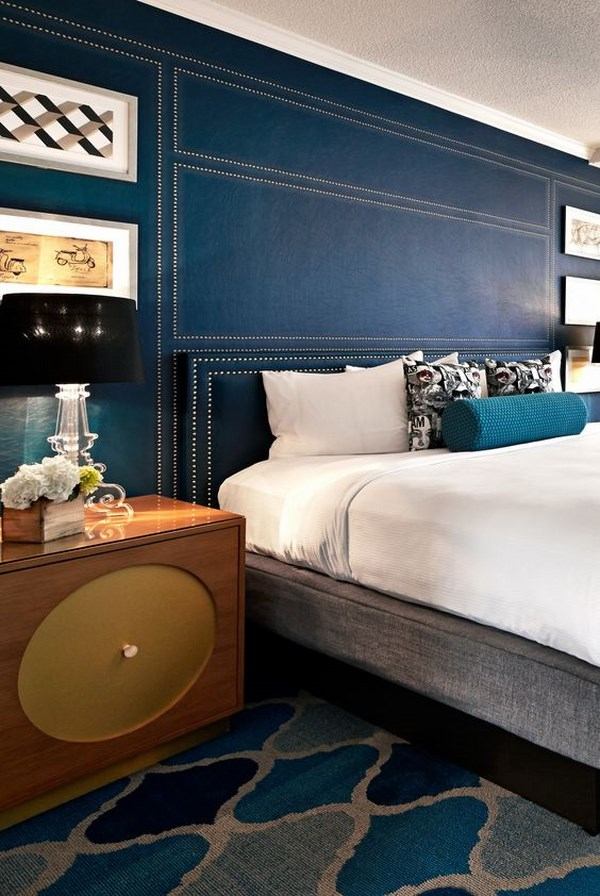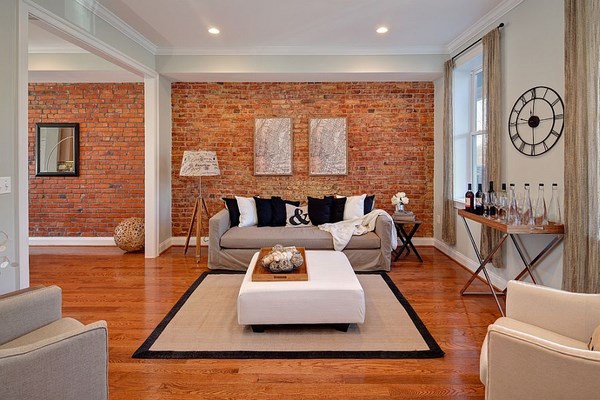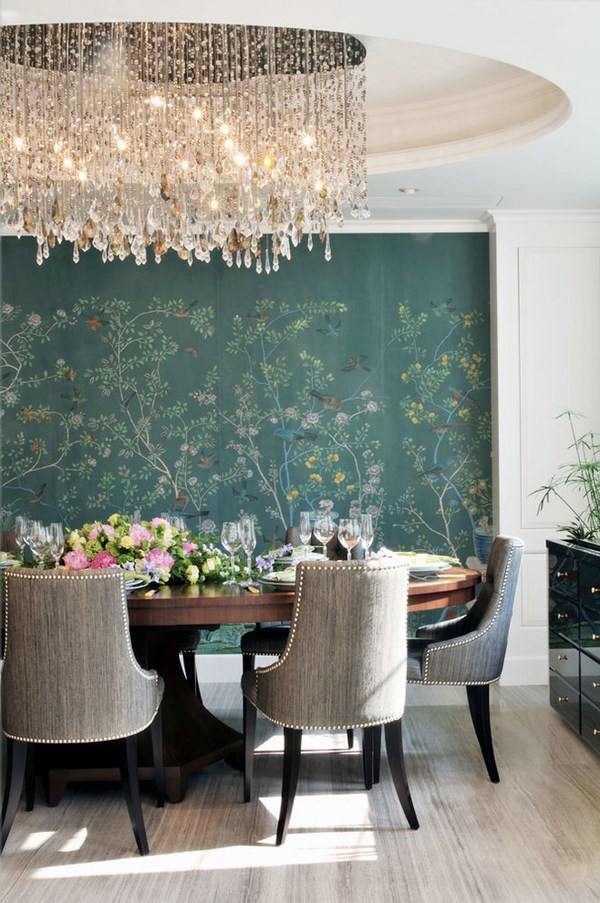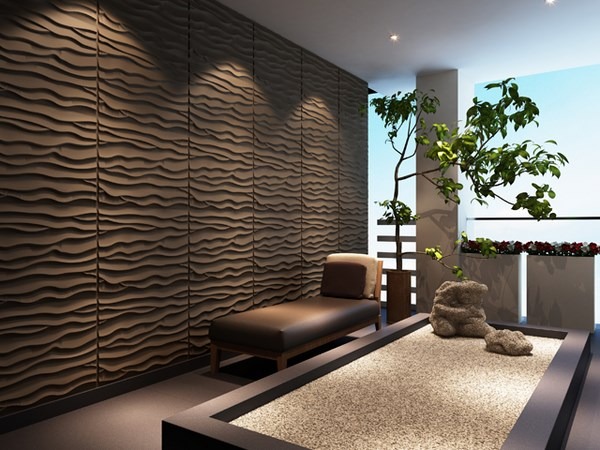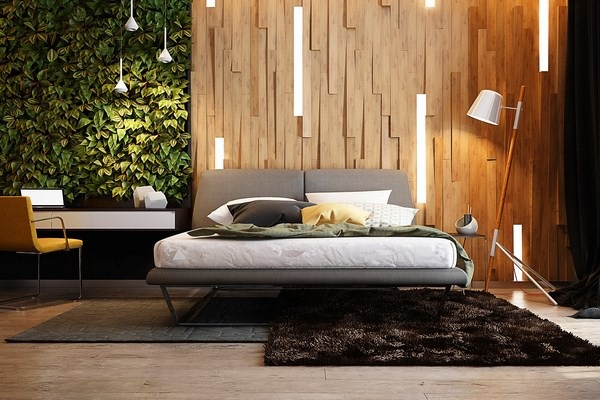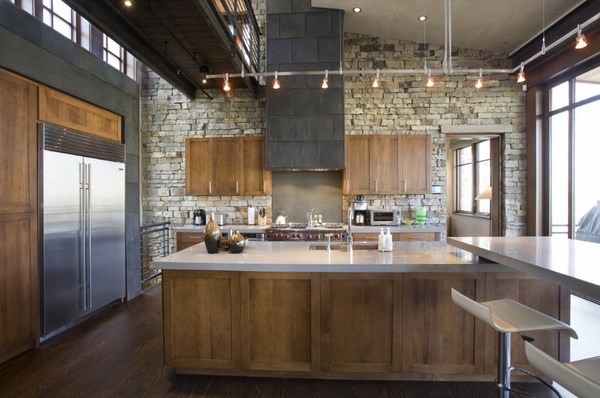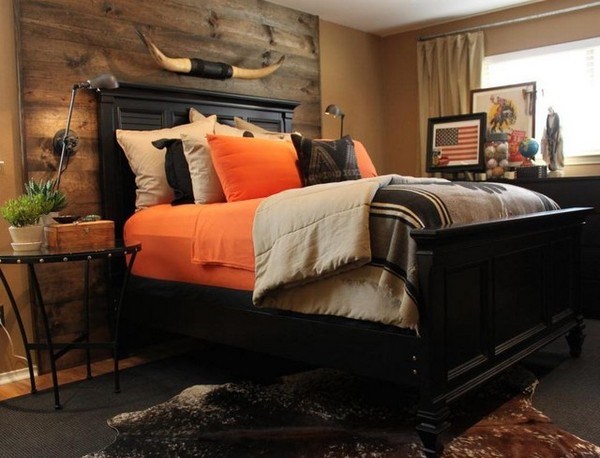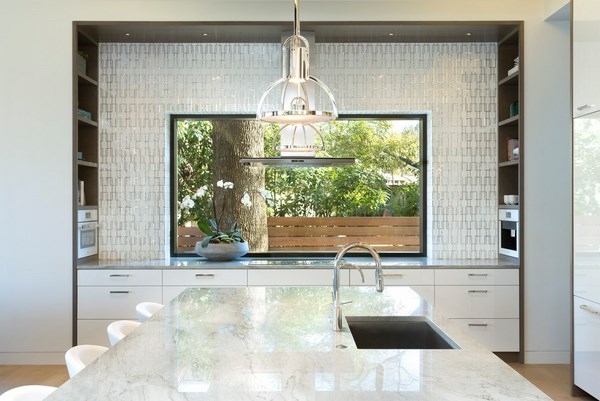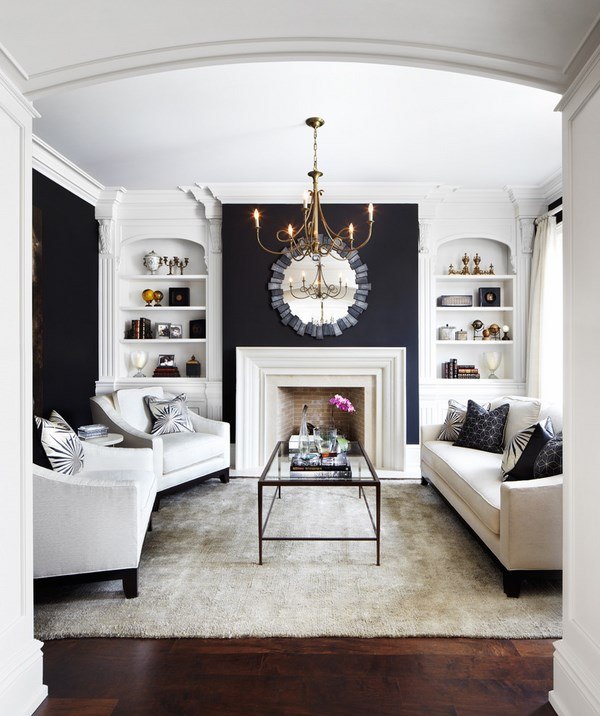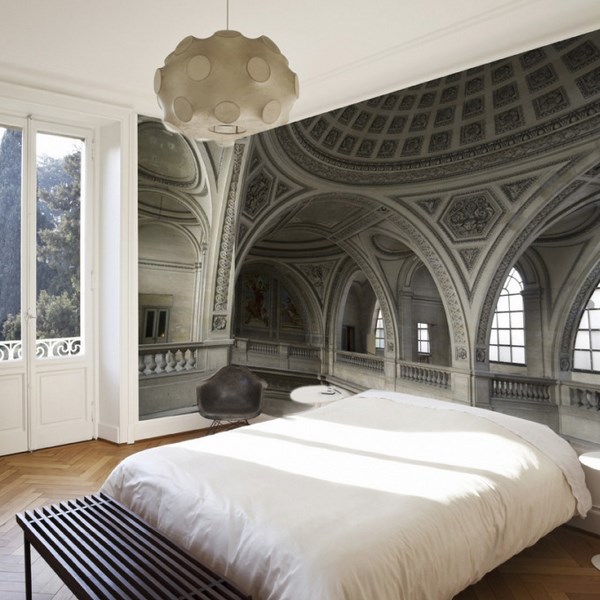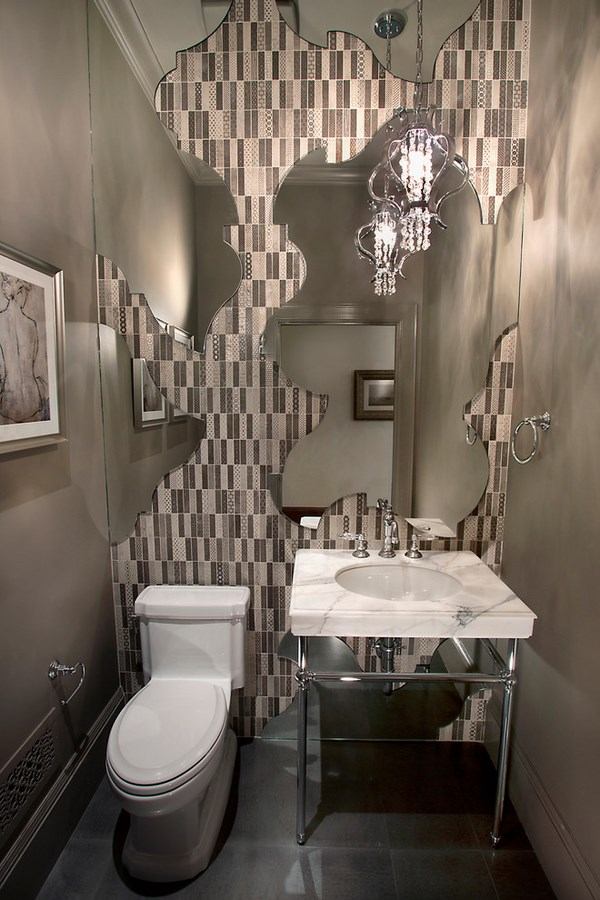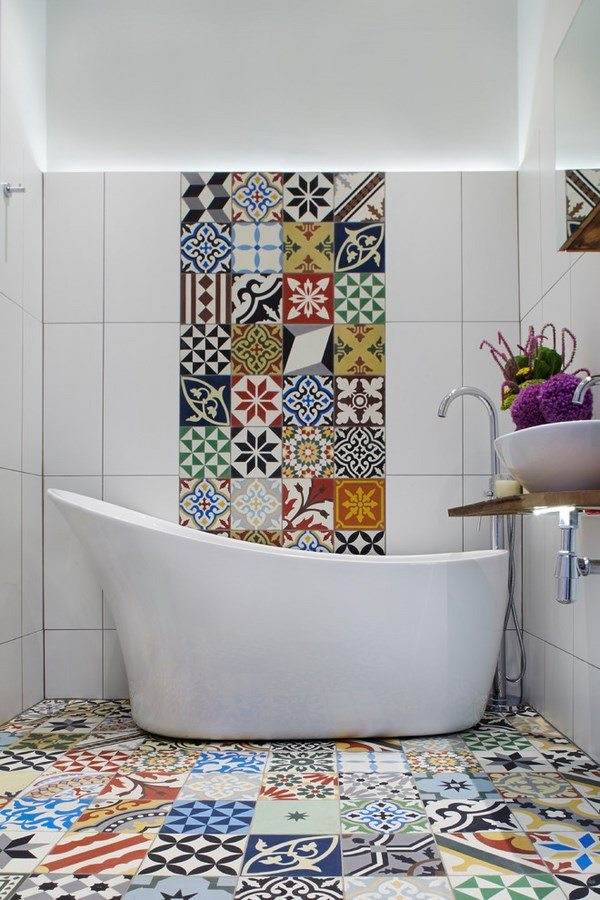Accent wall in interior design is a powerful tool and can be arranged in the decor of any room. For example, this is an easy way to make a living room brighter. In the bedroom, you can also create an interesting visual effect which will help for a special atmosphere or provide additional zoning. A bright wall for sure will be appreciated by the children which makes such walls especially suitable for nursery rooms and kids’ bedrooms. In the kitchen, such an accent can be quite appropriate and harmoniously work with the overall design.
What is an accent wall? Although the name speaks for itself, the definition of the term is used to describe a wall which stands out from the rest and has a different color, texture, pattern or finishing material. The accent can be the entire surface of the wall or only a part of it and is the “wow” factor, which designers like to use to instantly attract the attention of the viewer. As you know, it takes seconds to create a first impression and an accent adds originality, character and individuality to the room. In addition it can be used as the perfect background for highlighting some elements of the decor or the design elements the room, it can be used to visually expand or narrow the space or it can be used as a partition between functional zones in open floor plan spaces.
We shall have a detailed look at the various aspects and will see why it is a good idea to have an accent wall, which wall can be used as a focal point, the functions of such walls and of course the different ways to create one. In addition, we shall give you useful tips and ideas how to create an accent wall in the living room, bedroom, kitchen, even the bathroom.
Why create an accent wall?
This is one important question. Of course, people who are professionally involved in interior design and decoration know that this design technique is very powerful and provides numerous options to introduce bright colors, textures, shapes, lines and materials to the interior of the room. Further to that, accent walls are a great way to add dynamics to the interior and break a monotonous, uniform or flat appearance. An accent wall is also an ideal way to manipulate the attention and focus the eye on a spectacular and extraordinary element of the interior.
Those who would like to decorate their home by themselves, however, should know that there are some rules. The first question is – which wall can be accented? Could you make any wall a focal point of the room? In theory, nothing is impossible, but practice and common sense show that this method should be used carefully and with attention because instead of having an original element you may end up with a something quite ridiculous which visually changes in the proportions of the room. Here are some simple steps to determine which wall you can design as an accent one:
Draw a sketch of the room and see which wall can be left as free as possible. There is no point in creating an accent if you block it with furniture or accessories. In addition, you have to be certain that you want to draw the attention to it. Do not go for a random side wall just because it is solid. Obviously, the best option is a solid one without breaks or interruptions like windows of various sizes or a door opening. When you have to accent a wall with windows it is best if it is symmetrical.
Determine the type of finish you will use. For example, if you decide to play with color then remember that under certain lighting it can appear completely different from what you plan or expect to see. Testing the appearance of the color in natural and artificial light is a good idea. In addition, if the wall will be constantly exposed to direct sunlight some of the finishing materials can burn out or change their appearance and properties.
It is advisable to accentuate the wall that comes into view first. Ideally, it is the one located opposite the entrance. Otherwise, you will not be able to achieve the desired effect.
Depending on the purpose, you can choose to accent an entire large wall or a part of it. However, you need to keep in mind that an extensive accent wall is not always a good decision, especially if you choose a contrast color, as it may become dominant and ruin the visual proportions of the room.
In a room only one of the walls can be an accent wall. Two accent walls are an exception and this is very rarely used as a technique.
It is possible to accent only a part of one of the walls, or even focus on the architectural elements of the wall – arches, niches, etc. The choice of color is crucial – using warm or cold shades gives you an opportunity to create fantastic visual effects.
Do not forget that an accent wall sets the atmosphere of the whole interior and can finally balance the design of the room.
Another important thing that you should keep in mind is that there is no need to use additional elements which will enhance the effect of the accent wall. The idea of having such a wall is that it can work as an individual element of the design. However, this rule works successfully in rooms painted in light or neutral colors. When you have several different colors in the room it is better to colors which enhance the appearance of the accent wall or other decorative elements in the same color, for example – pillows, carpet, vases, lamp shades, furniture upholstery, etc.
How to design an accent wall in the rooms of the home?
It often happens that homeowners are not quite certain for the best location of an accent wall and feel worried whether their choice is right. There is no need to feel stressed or uncertain because it can be arranged in any room of the home – from the entry hall to bathroom – and as you saw – there are numerous ways to do it.
Accent wall in the hallway
The impression of the whole house begins with the entrance hall and it is not surprising that here you want to place the right accents, highlighting the area and creating the best first impression. An accent wall can help you visually enlarge a small and narrow hallway and create an illusion for more space. There are many particular characteristics that you need to consider when you choose the finish for the wall that you want to highlight – the function of the hallway, the location, the traffic, storage furniture, lighting, etc. You can choose a decor which will make the hallway a part of the overall color scheme of the home or choose a finish which will give special character and individuality to that area.
Accent wall in the living room
Most often in the living room you can find an accent on the wall with a TV. This decision is especially popular as designers try to make it more active in comparison with the design of other walls. You can draw the attention to the area behind the sofa (this can be a whole wall or a wide strip in the center). This wall can be an excellent background for interior details, paintings, photographs or a variety of decorative items. In a studio apartment or in an open floor plan living area you can use the accent wall for zoning and defining a particular functional area. Another popular option, if you have a fireplace, is to use that wall as an accent one and make it the focal point of the room, especially when you combine the materials of the fireplace surround and the wall itself.
Accent wall in the bedroom
The bedroom is a private space where you need to create a comfortable surrounding for a good rest. This is not a living room, where, in addition to gathering the whole family in the evenings, you entertain friends and visitors. Nowadays, a bedroom performs many functions and there may be a workplace and a wardrobe, so the design of the walls in the bedroom must be approached competently. The main goal is to create a balanced, calm and peaceful atmosphere which will please your eye. Whether you choose wallpaper with a delicate floral pattern, stripes, a warm, pastel or neutral color, elegant tufted wall panels or any other type of finish will depend on your personal preferences and style. Typically, the wall behind the headboard, is the choice for an accent wall, as this wall forms a composition with the bed, nightstands, lamps, curtains, if any, etc. However, you can break the rule and design your accent wall on the opposite one of the bed or even choose a side wall.
Accent wall in kid’s bedrooms and nursery rooms
The child spends a lot of time in the children’s room, especially in the early years of his life. The development of a small person is affected by everything that surrounds its mind – colors, shapes and textures. Only parents know what is best for their child – a calm neutral palette for calming hyperactivity or bright colors. Of course, many factors like functionality and practicality should be taken into account in addition to visually pleasing environment as children grow up so quickly and their needs and tastes change with age. It is logical that cartoons will not be a good choice for teen bedrooms as teenagers would prefer graffiti, fashion, sports, etc. Chalkboard paint wall, for example, is a good idea for small kids and teens. It is best if you choose warm, natural materials and avoid stone in kid’s bedrooms.
Accent wall in the kitchen
Modern kitchens are multi-functional areas for food preparation, dining, family gathering, and in open floor plan homes, they are a part of the living area which is visible and thus provides an opportunity to create a spectacular accent wall which will highlight the furniture or separate the kitchen from the dining area. Most people choose to accent the wall by extending the backsplash and there are many fantastic kitchen designs showing original and interesting concepts and different finishes – from brick and natural stone to tile and wallpaper, even paint. Small kitchens and galley kitchens can be completely transformed with the help of an accent wall as it can add visual depth and interest to a limited space. Of course, you need to choose the material with regard to its durability and waterproof properties, as the kitchen’s main function is food preparation. The good news is that the market offers a variety of materials that can emphasize the individuality of the interior and the attractive appearance even in increased humidity, constant changes in temperature conditions, etc.
Accent wall in the bathroom
An accent wall in the bathroom can be a real work of art. You can choose from many options – marble, onyx, beautiful tiles, wood or stone, vertical garden, etc. to add dynamics and texture in the bathroom. This is a great design technique for small bathrooms as well and allows you to create a real “wow factor”.
Accent wall ideas- original solutions and basic techniques
An accent wall can be decorated by using paint, wallpaper, decorative plaster, wooden panels, photo walls, bricks, ceramic tiles, stone or faux stone, etc. The opportunities are unlimited and you can use your creativity and imagination to create an amazing focal point in any room. Here are several design secrets that will help to make the right color choice for the accent wall.
Choosing a color for the accent wall is one of the most effective ways to create a focal point. Warm colors like red, orange, yellow and their shades make an accent wall appear closer to the viewer while cold colors like blue, green, purple and their shades make the wall appear further which, respectively, adds visual space to the room and it appears larger. An accent wall painted in a color which is close to the main color of the walls creates a peaceful atmosphere, but if you wished a more vivid and dynamic design, contrast colors will give you a better visual effect. When the room is decorated in neutral colors – white, black-and-white, gray, beige, beige-brown, etc. – you can select any color for the accent wall.
Look at the color wheel – analogous colors are the ones located next to each other in either the warm or cold half of the wheel. If you want something more energetic and impressive, choose complementary colors which are located opposite each other. For example: if the room is decorated in orange-yellow tones, the accent wall can be painted in blue shades. When the main color scheme of the room features bright colors it will be logical to use a rich and dark shade like chocolate brown, purple, dark blue, burgundy, black, graphite, etc. for he accent wall.
A wallpaper or a photo wallpaper for the accent wall offer numerous solutions and opportunities for any style of the interior and you can find interesting and original ways that emphasize the taste and personality of the owner of the apartment. When choosing wallpaper for the accent wall, you must first of all consider the size and shape of the room, the light conditions, the size of the wall itself, etc. as all these factors will affect the color, saturation and the pattern and the overall appearance of the wall. Wallpapers come in many varieties and materials and thousands of colors and patterns – paper, vinyl, acrylic, natural or textured (textile, bamboo, leather and others), etc. Depending on the desired effect and the overall interior design of the room you can opt for lighter or darker wallpaper. Avoid too bright and “acidic” tones, especially on large areas. In rooms with limited natural light you should avoid wallpaper in dark, saturated tones and in small rooms it is best if you chose a light color for your accent wall. Generally, the color scheme is selected in accordance with the chosen style of decoration of the room and personal tastes of the homeowner yet the final result should be a harmonious and balanced interior.
Modern photo wallpapers are bright and stylish and an excellent choice when you want to create an accent wall in any room if you use original images and avoid the common mistakes. The first rule is that the photo wallpaper, even if used to accent a wall, must be a continuation of the overall interior design. When choosing the image, consider the purpose of the room – for example, if you want to create an accent wall in the bedroom, an image of busy city streets is not the best choice. The image scale is also important – an image too small or too large for the particular room can ruin the effect and the overall impression of the accent wall. Another important rule when using photo wallpaper to accent a wall is to use just one image which will be the focal point. Do not use two photo wallpapers in one room as this will lead to a visual conflict and overload the interior. It is best to leave the accent wall free so that image is visible, especially when you have chosen photo wallpaper with perspective. How to choose the best photo wallpaper image for an accent wall? This will depend entirely on the overall design concept. For example, if you wanted to emphasize a modern interior using photo wallpaper with a cityscape, fragment of a city street or building will be a good idea. For a rustic interior, choose photo wallpaper with natural or rural themes. A geographic map is a very good choice for kids’ bedrooms.
Accent wall with ornaments, pattern or mural – you can use any of these techniques to create a stylish focal point in the room. This will bring new shapes and lines to the interior, which will allow you to manipulate the perception of the geometry of the room.
One of the most popular ways to accent a wall in a room is to use stripes. They are used very often simply as a decorative technique, which makes the interior more dynamic and lively. Typically, stripes in the interior are done by using contrasting colors that attract attention or in shades of one color, depending on the desired effect. Stripes can be used in almost any interior and style. The most important thing in this case is to choose a design that is suitable for your room, so that each detail looks harmonious. In terms of perception, you need to know that that narrow stripes in shades of one color may not be noticeable if you look at them from a distance while broad stripes will attract attention and will look spectacular and fashionable. Vertical stripes on the walls will add visual height to the room while horizontal stripes will make the room wider, but the ceiling will appear visually lower.
Chevron and herringbone patterns are also widely popular geometric patterns for accent walls and a great opportunity to add color to the interior and revitalize space. The zigzag angles of chevron and herringbone patterns on the wall immediately become a focal point. Like stripes, these patterns add volume to the room and a great effect on its geometry and mood. You could choose from numerous ways to introduce chevron and herringbone in a modern and bold way – wallpaper, paint, stencils, wood planks, wall tile, etc.
Floral ornaments on the accent wall will make the room more feminine and soft. Although, floral patterns are typical for interiors in the styles of Provence or Shabby chic, in vintage and classic interiors, they can be used in modern and contemporary designs as well. When considering a floral pattern for an accent wall you should clearly realize what results you want to achieve in the interior and the effect of floral patterns on the perception of space. One of the first rules that you need to observe is creating a balance – if you choose a floral pattern for your accent wall the rest of the interior should not distract the attention. Pay attention to the size of the flowers. Large and bright flowers are a beautiful element of design, but not in a small room as they appear overwhelming. Small flower patterns are a better option for small rooms. Again – the color balance is essential so choose wisely!
Wall murals have been used for centuries and even nowadays they add charm and sophistication to any room. Whether you choose a modern, classic or vintage mural will depend on the overall design concept.
Textured accent wall ideas – how to choose the material?
Adding new textures to the interior makes it visually interesting. The accent wall can be finished with brick, natural or faux stone, tiles, mosaic, wooden panels, 3D wall panels, decorative plaster, fabrics, etc. Brick and stone will perfectly fit in both urban and rustic styles. Wood and bamboo will emphasize the natural elements, but you can choose any other texture that works with the design concept of your home.
Stone has been used for a long time in interior design and always an actual way of wall decoration, especially when we talk about accent walls. The unique texture, natural beauty, excellent sound insulation and the wide choice of color make stone walls a popular choice. Stone works with wood, metal, textile and blends harmoniously in almost any design style.
A brick accent wall looks quite vivid, compared to a flat wall painted with paint, and gives the room a touch of antiquity and an atmosphere of individuality and mystery. Nowadays, exposed brick walls are a stylish element of interior decoration and although we see them most often in Industrial and Loft-style interiors, they work in an excellent way with contemporary and eclectic designs. Even those, who do not have authentic brick walls as original brickwork is rare, could enjoy the beauty of these walls – the market offers faux bricks, wallpaper with brick pattern and these are also budget friendly ways to have a spectacular accent wall. Bricks work perfectly with crystal chandeliers, antique furniture and retro accessories and look unusual and stylish, so do not be afraid to use your imagination.
Wood accent walls in the interior emphasize the comfort and warmth of the house. Natural wood is the most versatile material used not only for construction but in interior and decoration. Wooden walls are one of the best ways to create a focal point, regardless of the interior style as it works with minimalism, eclectic, traditional and any other style. The color and texture of wood combines with glass and metal, stone and ceramics and a decor made of wood panels or planks, shiplap, for example, makes the interior visually richer and more interesting. Wood has excellent insulating properties and in addition, this is a clever way to hide imperfections on the wall. Another advantage of wood is that it does not overwhelm the room and does not reduce its size. The unique wood grain adds to the individuality and character of the design and any room will benefit from a wooden accent wall.
Accent walls decorated with textile can be created by using different techniques – from hanging an antique rug or textile wallpaper to gorgeous tufted panels. This technique was popular many centuries ago and nowadays this kind of decor is experiencing a revival. The texture of fabric gives the interiors a special chic and respectability and you can choose from a great variety of textures – from the coarse flax, and soft velvet or a smooth satin – you will always find something to your liking. Textile is associated with warmth and comfort and in addition to the warm and cozy look, such accent walls have a presentable appearance and can give a really exquisite and expensive touch to the interior.
3D panels allow a creative wall design, which can completely change the space through color, texture and 3D effects. They are an excellent choice for accent walls and give you the chance to combine colors, textures and visual appeal. One of the main advantages of 3D panels is the ability to imitate almost any texture. Nowadays manufacturers offer different types of 3D wall panels made of a variety of materials – gypsum, plastic, wood, plywood or MDF, aluminum, etc.
These are just some of the techniques and materials to create a spectacular accent wall. Of course, there is no limit to creativity and imagination so you could choose something unexpected and original as a focal point in the room – tile, graffiti, mirrors, patchwork, window shutters, etc. The accent wall is the perfect place to display art – if you have a beautiful painting, do not hesitate to hang it on the accent wall. Posters, moldings, family photos – all of these can be used as well as additional technique to accent a wall in your home.

